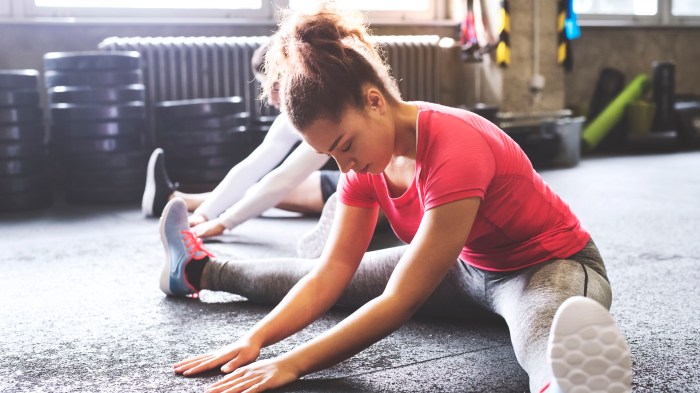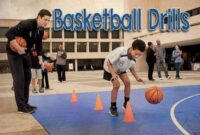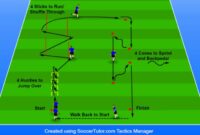Flexibility exercises for beginners takes center stage, this opening passage beckons readers with ahrefs author style into a world crafted with good knowledge, ensuring a reading experience that is both absorbing and distinctly original.
Flexibility is a crucial aspect of fitness, and incorporating the right exercises can make a significant difference. In this guide, we will explore the importance of flexibility exercises for beginners and provide tips on how to get started effectively.
Importance of Flexibility Exercises

Flexibility exercises play a crucial role in a beginner’s workout routine as they help improve range of motion, reduce muscle stiffness, and enhance overall physical performance.
If you’re looking to shed some pounds, consider taking up cycling for weight loss. Cycling is a great cardio workout that can help you burn calories and improve your overall fitness level while enjoying the outdoors.
Benefits of Incorporating Flexibility Exercises
- Increased Range of Motion: Flexibility exercises help to improve joint flexibility and range of motion, allowing for better movement during workouts and daily activities.
- Reduced Risk of Injuries: By maintaining flexibility in muscles and joints, the chances of injury due to overstretching or sudden movements are minimized.
- Improved Posture: Flexibility exercises can correct muscle imbalances and promote better posture, reducing the risk of back and neck pain.
- Enhanced Muscle Coordination: Stretching exercises help to enhance muscle coordination, leading to better performance during workouts and activities.
Types of Flexibility Exercises for Beginners
- Static Stretching: Involves holding a stretch position for a certain period to improve flexibility and reduce muscle tension.
- Dynamic Stretching: Involves moving parts of your body gradually to increase flexibility and prepare muscles for activity.
- Yoga: Combines stretching exercises with breathing techniques to improve flexibility, strength, and relaxation.
- Pilates: Focuses on core strength and flexibility through controlled movements and breathing patterns.
Basic Flexibility Exercises

When starting a flexibility exercise routine, it’s crucial to begin with basic exercises to avoid injury and build a strong foundation. Here are some simple stretching exercises that are ideal for beginners:
Neck Stretch
To perform a neck stretch, gently tilt your head to one side until you feel a stretch along the side of your neck. Hold for 15-30 seconds and then switch sides. Make sure to keep your shoulders relaxed and avoid any jerking movements.
Hamstring Stretch
For a hamstring stretch, sit on the floor with one leg extended and the other bent. Lean forward from your hips, keeping your back straight, and reach towards your toes. Hold for 15-30 seconds and then switch legs. Remember to breathe deeply and avoid bouncing.
When it comes to building muscle and increasing strength, incorporating the best strength training exercises into your routine is crucial. These exercises target major muscle groups and help you achieve your fitness goals effectively.
Quad Stretch
To stretch your quadriceps, stand with one hand against a wall for support. Grab your ankle and gently pull your heel towards your glutes. Hold for 15-30 seconds and then switch legs. Keep your knees close together and avoid arching your back.
For those interested in maximizing their strength gains, incorporating compound exercises for strength is key. Compound exercises work multiple muscle groups at once, making your workouts more efficient and effective.
Dynamic vs. Static Stretching, Flexibility exercises for beginners
- Static Stretching: Static stretching involves holding a position for a prolonged period, usually 15-30 seconds. This type of stretching is ideal for beginners as it helps improve flexibility and relax muscles.
- Dynamic Stretching: Dynamic stretching involves moving a joint through its full range of motion in a controlled manner. While dynamic stretching is beneficial for warming up before exercise, beginners should focus on static stretching to avoid overstretching.
Sample Flexibility Exercise Routine
| Exercise | Duration |
|---|---|
| Neck Stretch | 2 sets of 15-30 seconds each side |
| Hamstring Stretch | 2 sets of 15-30 seconds each leg |
| Quad Stretch | 2 sets of 15-30 seconds each leg |
Tips for Beginners: Flexibility Exercises For Beginners

When starting flexibility exercises as a beginner, it is important to be aware of common mistakes that can hinder progress. These mistakes often include pushing too hard, neglecting proper warm-up, and not listening to your body’s limits. To avoid these pitfalls and improve flexibility over time, it is essential to follow a few strategies and create a progression plan.
Common Mistakes to Avoid
- Avoid pushing your body too hard: Overstretching or forcing your body into positions beyond its current capabilities can lead to injuries and setbacks.
- Neglecting warm-up exercises: Failing to properly warm up before stretching can decrease the effectiveness of the exercises and increase the risk of muscle strains.
- Ignoring pain or discomfort: It is crucial to listen to your body and stop any exercise that causes pain. Pushing through pain can lead to injuries and long-term damage.
Strategies for Improving Flexibility
- Start slowly and gradually increase intensity: Begin with gentle stretches and gradually work your way up to more challenging exercises as your flexibility improves.
- Focus on proper form: Ensure that you are performing each stretch correctly to target the intended muscle groups and avoid strain.
- Be consistent: Consistency is key when it comes to flexibility training. Aim to incorporate stretching exercises into your routine regularly.
Progression Plan for Beginners
- Set realistic goals: Establish achievable goals for improving flexibility and track your progress over time.
- Incorporate a variety of stretches: Include a mix of static, dynamic, and PNF stretches in your routine to target different muscle groups.
- Gradually increase duration and intensity: As your flexibility improves, gradually increase the duration and intensity of your stretching exercises to continue challenging your muscles.
Frequency of Flexibility Exercises
- Beginners should aim to perform flexibility exercises at least 2-3 times per week to see improvements in range of motion and overall flexibility. Consistency is key, so try to incorporate stretching into your routine on a regular basis.
Safety Precautions
It is crucial to prioritize safety when engaging in flexibility exercises to prevent injuries and maximize the benefits of your workout routine. Here are some important safety precautions to keep in mind:
Importance of Warming Up
Before starting any flexibility exercises, it is essential to warm up your muscles and prepare your body for movement. Warming up increases blood flow to the muscles, making them more pliable and less prone to injury.
Tips to Avoid Overstretching and Injuries
- Avoid bouncing or jerking movements when stretching to prevent overstretching and muscle strain.
- Listen to your body and stop if you feel any sharp pain or discomfort during an exercise.
- Gradually increase the intensity and duration of your stretches to avoid pushing your body beyond its limits.
- Focus on proper form and technique to ensure effective stretching without compromising safety.
Role of Breathing Techniques
Proper breathing techniques play a significant role in flexibility exercises by helping to relax the muscles and improve overall performance. Take deep breaths and exhale slowly during each stretch to enhance flexibility and reduce tension.
Importance of Listening to Your Body
It is essential to pay attention to how your body responds to each stretch and exercise. If you experience any sharp pain, discomfort, or unusual sensations, stop immediately and modify the exercise as needed. Pushing through pain can lead to injuries and setbacks in your fitness journey.
In conclusion, mastering flexibility exercises as a beginner can lead to a healthier and more active lifestyle. By following the tips and exercises Artikeld in this guide, you can gradually improve your flexibility and overall well-being.



